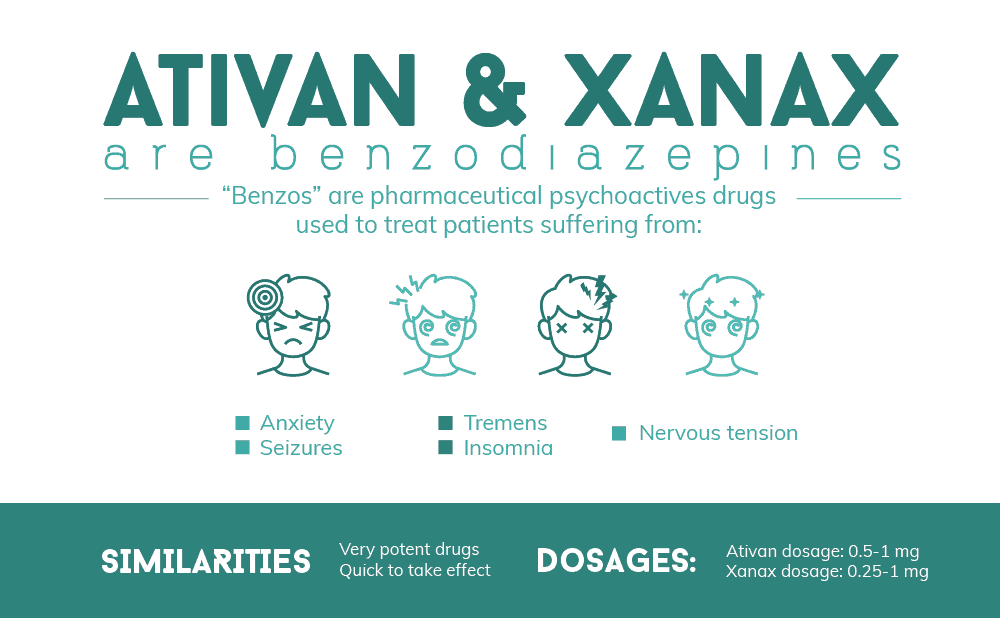When managing anxiety, benzodiazepines often come into play due to their fast-acting and effective relief. Among the most commonly prescribed are Ativan (lorazepam) and Xanax (alprazolam). While both medications are effective in treating anxiety, they differ in several key areas, including their onset of action, duration, potency, potential side effects, and appropriate usage. Understanding these differences is crucial for both patients and healthcare providers when choosing the best treatment option.

1. Onset and Duration of Action
Both Ativan and Xanax are known for their rapid onset of action, making them suitable for acute anxiety relief. Ativan typically begins to take effect within 15 to 30 minutes, providing relatively quick relief from anxiety symptoms. Its effects can last for about 6 to 8 hours, making it suitable for use during the day without causing excessive sedation or interference with daily activities.
Xanax, on the other hand, is one of the fastest-acting benzodiazepines, with effects typically felt within 10 to 20 minutes. However, it has a shorter duration of action, lasting around 4 to 6 hours. This rapid onset makes Xanax particularly effective for sudden, intense bouts of anxiety, such as panic attacks, but it may require multiple doses throughout the day to maintain its effect.
2. Potency and Dosage
Xanax is considered to be more potent than Ativan on a milligram-to-milligram basis. For example, 0.5 mg of Xanax is roughly equivalent to 1 mg of Ativan in terms of its anxiolytic (anxiety-relieving) effects. This higher potency means that lower doses of Xanax can achieve the same level of anxiety relief as higher doses of Ativan.
3. Side Effects and Risks
Both Ativan and Xanax share common side effects typical of benzodiazepines, such as drowsiness, dizziness, and impaired coordination. However, due to its shorter duration of action, Xanax has a higher potential for rebound anxiety, where symptoms return more intensely as the medication wears off. This can lead to a cycle of frequent dosing, increasing the risk of dependence.
Ativan, with its slightly longer duration of action, may have a more balanced effect, reducing the likelihood of rebound anxiety. However, like all benzodiazepines, it can still lead to dependence, especially with prolonged use. Both medications also carry the risk of withdrawal symptoms if discontinued abruptly, so they should be tapered under medical supervision.

4. Appropriate Uses
Ativan is often chosen for its longer duration of action and is commonly prescribed for generalized anxiety disorder (GAD), as well as for anxiety related to medical procedures, insomnia, or seizures. Its less intense effects make it suitable for patients who need anxiety relief without the pronounced sedation that can interfere with daily functioning.
Xanax, due to its rapid onset and high potency, is frequently used for acute anxiety attacks, particularly panic disorder. Its ability to provide quick relief makes it ideal for situations where anxiety symptoms come on suddenly and intensely. However, because of its potential for rebound anxiety and dependence, it is generally prescribed for short-term use.
Conclusion
The choice between Ativan and Xanax for anxiety management depends on the specific needs of the patient and the nature of their anxiety symptoms. Ativan’s longer duration and less intense effects may be preferable for ongoing anxiety management or for patients who require steady, controlled relief. Xanax’s rapid onset makes it a powerful option for acute anxiety or panic attacks but requires careful management due to its shorter duration and higher potency.
Ultimately, the decision should be made in consultation with a healthcare provider, who can assess the patient’s symptoms, medical history, and potential for medication dependence. By understanding the unique characteristics of each medication, patients can make more informed choices and work towards effective, personalized anxiety management.